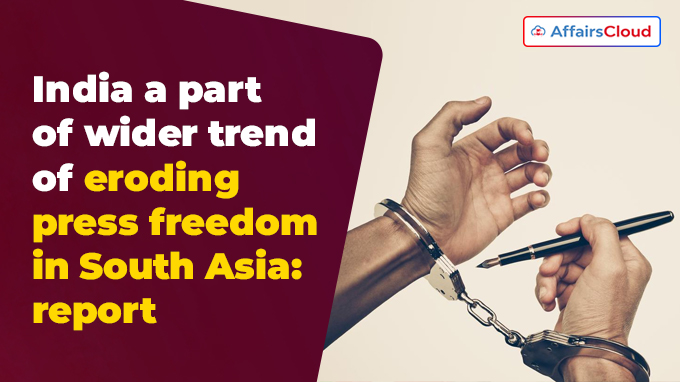 In May 2025, Brussels (Belgium)-based International Federation of Journalists (IFJ), on behalf of the South Asia Media Solidarity Network (SAMSN) released the 23rd Annual South Asia Press Freedom Report(SAPFR 24-25), titled ‘Frontline Democracy: Media and Political Churn’. As per the report, India is a part of a wider trend of eroding press freedom in the South Asia region.
In May 2025, Brussels (Belgium)-based International Federation of Journalists (IFJ), on behalf of the South Asia Media Solidarity Network (SAMSN) released the 23rd Annual South Asia Press Freedom Report(SAPFR 24-25), titled ‘Frontline Democracy: Media and Political Churn’. As per the report, India is a part of a wider trend of eroding press freedom in the South Asia region.
- The report highlighted that Indian media ‘has been shackled and subjected to a systematic strategy to cripple it’.
- The SAPFR 24-25 was formally launched during UNESCO’s World Press Freedom Day 2025 event held at Kathmandu, Nepal.
About SAPFR 2024-25:
i.The report is produced with the support from Paris (France)-based United Nations Educational Scientific and Cultural Organisation (UNESCO); Norsk Journalistlag (NJ); European Commission (EC); and National Endowment for Democracy (NED).
ii.The report annually reviews the state of press freedom in 8 South Asian countries, namely: India, Pakistan, Afghanistan, Sri Lanka, Bangladesh, Nepal, Bhutan, and Maldives.
iii.This latest edition of the report has covered the complexities and challenges of an industry that is endeavouring to find stability in democratic spaces driven by political challenges and massive economic and civil disruptions from May 01, 2024 to April 30, 2025.
Key Findings:
i.The report recorded a total of 250 media rights violations in 2024-25, which included the targeted killings of 20 journalists and media workers, up from 8 deaths reported in 2023-24 period.
ii.The report highlighted journalists across the South Asia region faced attacks, arrests, and detention with at least 70 media professionals jailed or detained and more than 190 journalists were assaulted, threatened, or harassed, often by law enforcement.
iii.Also, the report has raised several concerning trends, like: a “increasing trust deficit in media outlets”, “choking of independent websites” and “extreme precarity of gig workers who are also facing challenges posed by Artificial Intelligence (AI)”.
iv.As per the report, Pakistan witnessed the “most violent year for journalists in the country” in 20 years, with 8 journalists killed in the period under review.
v.The report highlighted some of the major threats which pose challenges to the media: unprecedented obstacles on freedom of expression in Afghanistan, the undemocratic polarization of new across the entire South Asian region and the rise of AI tools and misinformation.
India-Specific:
i.The report has a section specifically dedicated to India titled ‘India: Propaganda and the Press’. This particular section of the report flagged the proliferation of hate speech and disinformation with the Information Technology (IT) cells of political parties playing a significant role in it.
ii.The report has outlined the frequent use of certain laws like: defamation laws, sedition laws, the Unlawful Activities (Prevention) Act (UAPA) and Prevention of Money Laundering Act (PMLA), to suppress media freedom.
iii.The report highlighted the Global Risks Report 2024 released by World Economic Forum (WEF), which has found manipulated and falsified information to be the “most severe short-term risk the world faces”.
- It identified India at the highest risk of misinformation and disinformation globally.
iv.The report underlined various other challenges which India media faces specifically and the South Asia region in general, and these are: media workforce reeling under ‘shrunken job market’, the ‘increasing use of AI for content creation’, decrease in advertisement revenue, new labour codes promoting contractual work, among other.
About International Federation of Journalists (IFJ):
It is the largest organisation of journalists in the world. It comprises 6 lakh media professionals from 187 trade unions and associations over 140 countries.
President- Dominique Pradalié
Headquarters- Brussels, Belgium
Established- 1926




